Apple iPhone 6s Plus vs Samsung Galaxy Note5
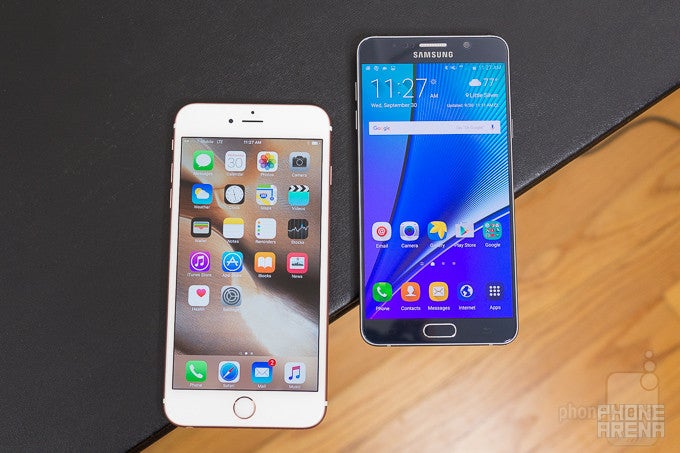
Introduction
Danger, danger, big screens incoming! The new Apple iPhone 6s Plus and Galaxy Note5 are poised to become the most talked-about phablets for the foreseeable future, so we are left with no choice but to stage a cage fight between these two juggernauts of the mobile industry.
Thin and with premium build, the phones are not only stuffed to the gills with the best that the mobile hardware industry can offer, but also offer two distinctively unique extra input methods – the new and clicky S Pen on the Note5, and the 3D Touch pressure-sensitive screen on the 6s Plus. Which one is to prevail? Read on to find out...
Design
With a premium chassis and record screen-to-body ratio, the Note5 design is now a match for the larger iPhone.
Both handsets feature premium materials in their design build, with Apple betting on a durable 7000-series aluminum unibody, and Samsung cladding its Note5 in a glass and metal chassis. The Note5 uses thermal nanocoating, applying numerous layers to achieve transient, reflective mirror effect. The metal side frame feels quite slippery in the hand, though, and so is the metal body of the iPhone 6s Plus. The choice of premium materials, and the extra functions that both phablets boast, are making them rather heavy in the hand, especially the iPhone, which clocks in at the cringing 6.77 oz (192 g), while the Note5's chassis comes in at 6.03 oz (171 g) .
Apple's handsets, including the iPhone 6s Plus don't have good screen-to-body ratio. Meanwhile, the Note5 excels in that metric, thanks to slim bezels all around.
Long story short, the 5.7” Note5 is more compact than the 5.5” iPhone 6s Plus; moreover, it still finds a place for the S Pen stylus silo on the lower right corner. Nevertheless, Samsung's phablet is still a pretty big device that is not comfortable to use with one hand, or carry in tight pockets, and the iPhone 6s Plus takes those portability dramas even further.
Display
Apple's 3D Touch screen technology adds extra layer of input possibilities that will likely see more use on a daily basis than the stylus input.
Apple and Samsung are renowned for their display quality prowess, and their poster kids don't disappoint. Equipped with diametrically opposite screen technologies – LCD for the iPhone 6s Plus and AMOLED for the Note5 – they converge when it comes to the quality of their panels. The Note5 has the upper hand when it comes to pixel density, as it sports 1440x2560 pixels Quad HD resolution, against the 5.5” 1080p panel of the iPhone 6s Plus, which can't really be considered a disadvantage at today's crazy pixel densities.
When it comes to color presentation, brightness, contrast and viewing angles, the phones deliver on all fronts. The iPhone 6s Plus displays slightly colder colors overall, when measured against the 6500K white point benchmark, but not to the point of this being severely noticeable, whereas the Note5, on paper, comes out closer to the reference point, yet this is only in one of its screen modes – Basic – and not in the default Adaptive Display regime. Moreover, even in the Basic mode, when you tilt the phone about 30 degrees or further, the colors become every bit as cold as we were accustomed to with AMOLED displays before Samsung started outing them with more credible color presentation in the last year or so. Speaking of viewing angles, they are great on both phones, even to the extremes.
When it comes to outdoor visibility, the two phones seem about on par. The iPhone 6s Plus has higher peak brightness, though in auto mode, the Note5 can boost its brightness well beyond its measured peaks, and perform admirably, too, due to the low screen reflectivity, and its high contrast. The Note5's display has a supersensitive mode, allowing you to operate it with gloves on, but this has nothing on the iPhone 6s Plus pressure-sensitive screen layer, called 3D Touch, that can distinguish between a normal tap, and a deeper press, and react accordingly.
Interface and functionality
We won't be comparing the two user interfaces directly, as these are well-known to every phone aficionado out there, and will just mention that Note5 is running on Android 5.1 Lollipop, with 6.0 Marshmallow to follow, while the 6s Plus puffs with the newest iOS 9 out of the box. Suffice it to say that the new TouchWiz Android overlay of Samsung is still heavier, carrying more features – some useful, some more obscure, than the straightforward iOS on the iPhone.
What we want to focus on are the unique selling points of the two phones that set them apart in terms of input methods, and the resulting divergence in interface features and functionality. We are talking about the S Pen stylus on the Note5, and the 3D Touch display of the iPhone 6s Plus, of course.
Starting with the pressure-sensitive screen on the iPhone, one can argue that this is a more useful addition to the input methods of our phones, as it doesn't require any separate gear, just your finger tip. You can evoke context menus with a harder press, and choose from their options without having to first go into the app, for example; not to mention the influx of cool features that third-party apps are bound to get in the near future (some already have).
The S Pen, on the other hand, now lets you scribble on the screen directly without even unlocking the Note5, and is more precise and smooth in its writing abilities. You can also annotate PDFs and other documents with it directly, without taking a snapshot first. Speaking of screenshots, a new S Pen functionality allows you to take a scrolling one, meaning that you can now mark and copy an entire website, for instance, not only the visible part. The Note5 is arguably better in its multitasking abilities, as it allows you to split the screen in two, and run separate apps at once, or even have two instances of the same app open side by side, should the need occur.
After the stylus novelty wears off, Note owners usually say that they whip out the S Pen only on occasion, and the same might happen with the 3D Touch display on the iPhone 6s Plus, but still, given that it requires only your finger for extra input again, you might use the functionality it brings more often than you would use the S Pen on the Note5.
Processor and memory
The Apple A9 chipset in the iPhone 6s Plus is a dual-core undertaking clocked at 1.8 GHz, and built with a similar production process to the octa-core Exynos 7420 in the Note5, which is clocked higher, at 2.1 GHz maximums. What sets these chipsets apart is that they are both in-house creations of Apple and Samsung, respectively, and are the most powerful and well-optimized mobile silicon currently on offer. The A9 gives way a bit in the multi-core tests, but has the upper hand in single-core scenarios, as it runs Apple's own custom core architecture that is faster on a clock-for-clock basis.
These are all geeky stats, though, while both chipsets perform admirably, especially the A9 powering the polished and slimmed-down iOS 9. The Exynos chipset performs fine, too, given that it has to deal with Samsung's heavy TouchWiz overlay, and all of its eye-candy. Of course, having 4 GB of DDR4 RAM, as the Note5 does, helps for the performance as well. Apple has doubled the RAM to 2 GB now, which on iOS lets you load tens of apps at once without having to constantly zap them to free operating memory.
Speaking of memory, the internal storage of the basic iPhone 6s Plus model starts at the paltry 16 GB, while the Note5 will take you off with 32 GB, and that's important since the handsets don't offer expandable storage via a microSD slot.
Internet and connectivity
With a record number of LTE bands, the iPhone 6s Plus has the upper hand in connectivity, at least for globetrotters.
When it comes to browsing the Internets, these two handsets will offer you the mobile web as good as it gets, as both their browser benchmarks, and the real-life usage signify. They render pages extremely quick (especially if on the Note5 you use Samsung's stock browser, instead of Chrome), and offer extras like reading modes and ad blockers. Panning and zooming are a beauty to perform.
Delivering those web pages to you over a data connection comes with the lightning fast up to 450 Mbps LTE speeds on the Note5, and the slower on paper 300 Mbps on the iPhone, though you'd be hard-pressed to find carriers that can provide even a tenth of these speeds. The iPhone 6s Plus has a much more useful advantage to brag with, though, as it supports no less than 23 LTE bands, which is a record for the phone industry. Other than that, the phones also support HSPA+ speeds, Bluetooth 4.2, and all the wireless radio assortment you might need.
Camera
The iPhone 6s Plus boasts a new 12 MP camera sensor, and larger, 1.22 micron pixels than the 1.12 micron ones of the 16 MP unit on the Note5. Optical image stabilization is present for both, while the Note5 boasts a wider f/1.9 aperture, compared to the f/2.2 one on the iPhone.
The camera interfaces boast a plethora of basic options like Panorama and HDR, but the Note5 takes the shooting modes and manual regimes much further, offering exposure, saturation and ISO adjustments. Apple hits back with the so-called Live Photos mode, which records short clips with each shot, so you can make every snap spring to life afterward as a GIF image of sorts.
When it comes to focusing and taking a shot, the phones are some of the fastest out there, with a split second between the shots, even in low light, and ways to launch the cameras directly from the lock screen. The iPhone is slightly faster to focus and take a shot, though in real life the difference is almost unnoticeable. The Note5, however, lets you enter the camera app directly with the display turned off by simply pressing the home key twice in a quick succession.
Pictures taken with these two phones are some of the best that the mobile revolution can currently offer, especially in low-light scenarios, which are the Achilles heel of handset cameras. Both phones are able to produce credible color presentation, although the colors coming from the iPhone 6s Plus camera are slightly warmer than the ones produced by the Note5. Details coming from both cameras in daylight are plenty, and very well-defined, with a slight advantage for the Note5 here. Apple's phone also scores more points in tricky dynamic range scenarios - better representing all the clouds and hues when shooting against a sky patch, for instance, without over- or underexposing it.
When the light starts to dim down, the phones' imaging prowess starts climbing up, when compared to the vast majority of their competitors. The iPhone 6s Plus now uses its optical image stabilization mechanism for photos, not only in video recording, and it shows in the night photos, where light sources have a bright halo around them due to the slower shutter speeds used, which happens on almost every phone with OIS.
At night, the handsets' positions as far as color reproduction goes get reversed, with the Note5 producing slightly warmer shorts than the iPhone 6s Plus. Meanwhile, exposure is largely the same, while the ever so slight detail superiority of the Note5 continues to be noticed.
The front cams are both with 5 MP of resolution and offer wide-angle shots that can fit more people in the frame than usual. The Note5's selfie-snapper does a tad better job indoors, though, with less noise and clearer pictures. The iPhone 6s Plus offers a flash of sorts for selfies, which lits the whole display in overdrive to illuminate the faces in the scene, which proves to be beneficial in darker environments.
Moving on to video footage, Apple introduces 4K recording abilities with the iPhone 6s Plus, which the Note5 does as well, albeit with a limit of 5 minutes per clip. In addition, the 6s Plus now does slow-mo HD footage with 240fps, while the Note5 maxes out at 120fps. Overall, the handsets take great 4K and 1080p video, although that of the Note5 appears somewhat wobbly in comparison. Still, colors are accurate, exposure adjustment is very fast, and so is continuous autofocus.
Multimedia
With their 3B (big, bright, and beautiful) displays, the phablets won't leave you longing for more when it comes to picture or video playback in the galleries or with the stock players. The Note5 supports every major format thrown at it, playing even 4K videos without a hitch, while on the 6s Plus some formats are a no-go, and you can just copy video to its memory, if you don't go the iTunes way.
Samsung's gallery looks a bit blocky and less polished than the iOS 9 one, but when it comes to functionality, it really is quite feature packed.
When it comes to music playback, the iPhone delivers fuller sound through the loudspeaker, with strength on par with the Note5, and also flaunts more powerful output with headphones plugged in.
Call quality
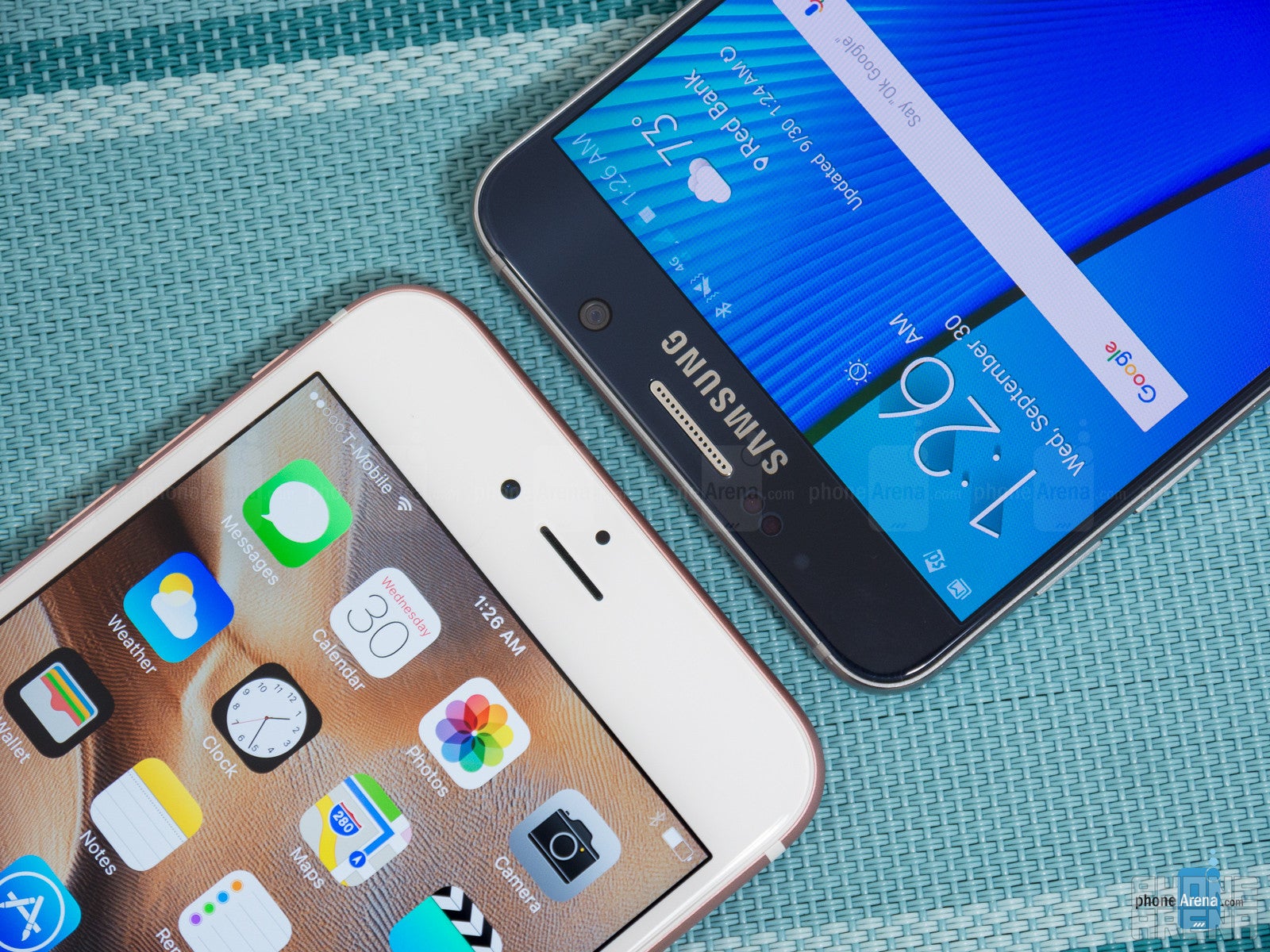
Still, we feel like the microphone of the Note5 is underperforming when directly compared to the 6s Plus. The Samsung phablet was prone to subduing our voice and the other end of the line had a slight trouble hearing us in certain situations.
Battery
As both phones sport equally great battery lives, the advantage goes to the Note5 and its ultrafast charging times, both on the wired and wireless side.
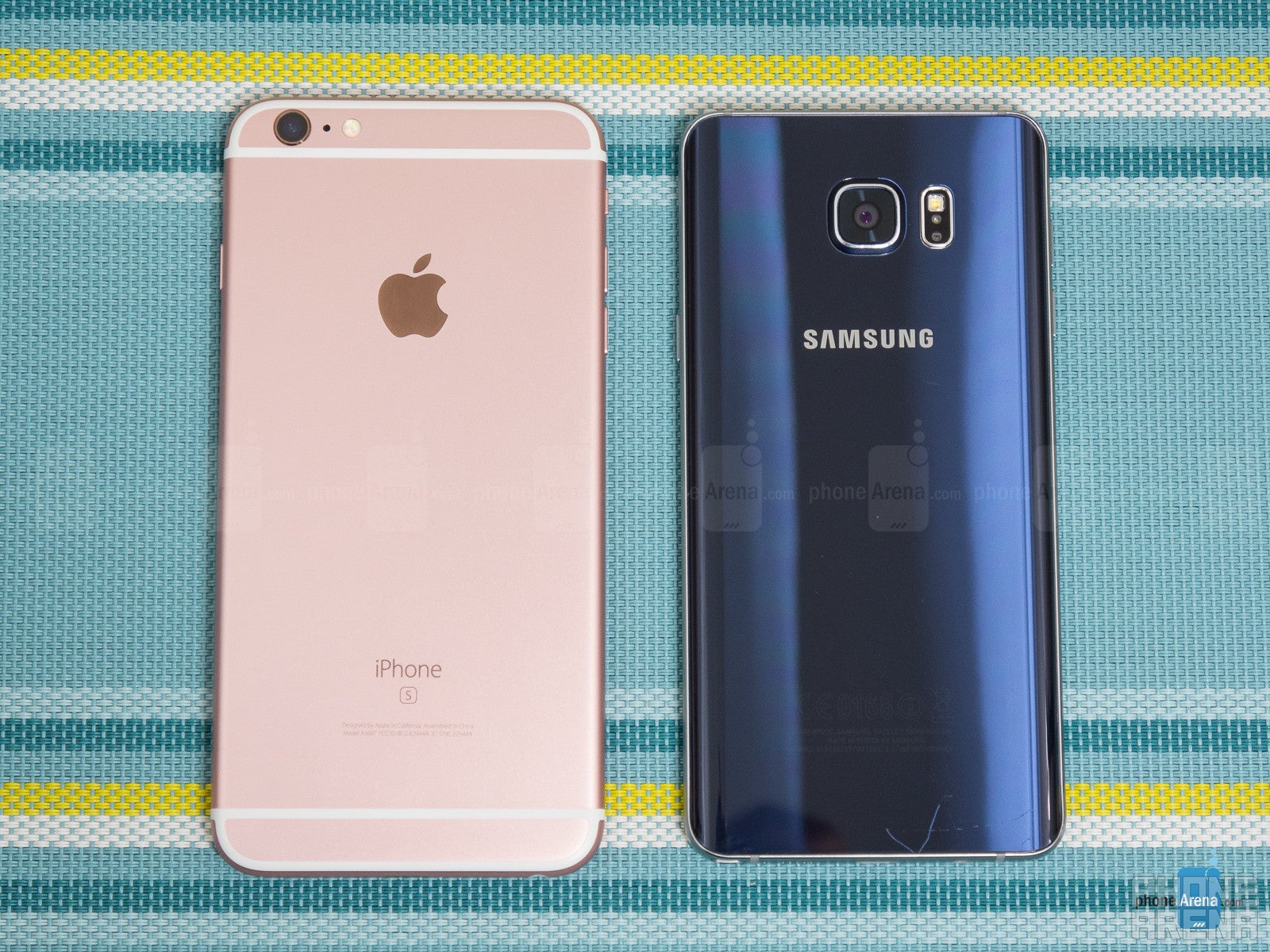
The iPhone 6s Plus, however, also comes with a 14nm or 16nm chipset, a new screen tech, and optimized iOS 9. How much did it score on our battery test? Well, it lasted exactly as long as the Note5 - 9 hours and 11 minutes – despite having a smaller, 2750 mAh pack.
Long story short, both phones flaunt excellent battery lives, and will easily get you through a full day on a charge, and even a weekend of light usage. The Note5 charges much faster than the iPhone 6s Plus, though, and has zippy wireless charging, too.
Conclusion
Apple's iPhone 6s Plus and Samsung's Note5 are the big-screen phones to get this season, especially if you can afford to part with $700+ for each of those. With premium builds, quality displays, and the best cameras in the iOS and Android universes, these two are in a league of their own when it comes to the basics. Both companies didn't stop here, though, but threw in unique features to set them apart from anyone that tries to encroach on their turf.
Setting superlatives aside, when it comes to the nitty-gritty, the phones leave a rather different impression. The Note5 has a record screen-to-body ratio for a 5.7-incher, which is a very important metric when it comes to phablets, while the 6s Plus is considerably larger and heavier. Both are difficult to operate with one hand, though, so we'll move on from here.
As both are more than powerful for what they run, while choosing iOS or TouchWiz is a matter of personal preference or whatever ecosystem you have already invested in, we are left with the phones' unique features to really set them apart from each other. With the stylus as a more precise input method, and the extra multitasking options like the split-screen view, Samsung's handset has the upper hand when it comes to productivity, yet the 3D Touch functionality of the iPhone 6s Plus display would arguably see more use on a daily basis than the S Pen and its accompanying abilities on the Note5.
Thus, if you aren't already too invested in iOS or Android, just enter the store, grab the phones, and pick whichever you think looks better and fits your palm and pocket well – you can't go wrong with either one. If you have to switch sides, though, better stick with your current ecosystem, as neither one is that more enticing than the other to warrant the swap, unless you are really curious. Last but not least, don't forget that the $750 iPhone 6s Plus starts you off with 16 GB of storage only, while the basic 32 GB Note5 can now be had for $650 or even less, which can also tip the scales for you.
Apple iPhone 6s Plus
Pros
- Handy 3D Touch pressure-sensitive display tech
- Better app ecosystem
- Smoother, more reliable performance
Samsung Galaxy Note5
Pros
- Great screen-to-body ratio
- S Pen stylus with useful features
- Extremely fast wired and wireless charging

Follow us on Google News
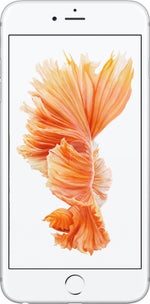
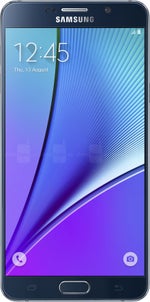














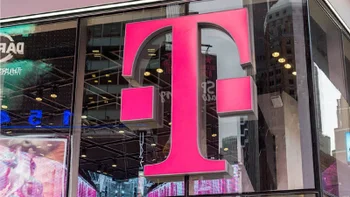












Things that are NOT allowed:
To help keep our community safe and free from spam, we apply temporary limits to newly created accounts: